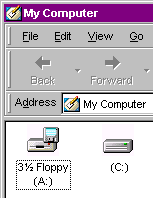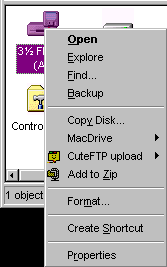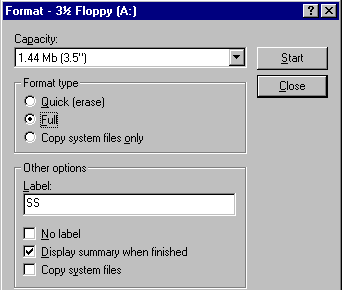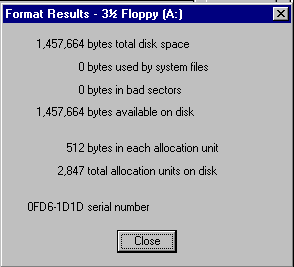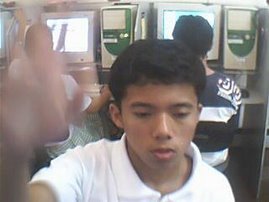How to partition your hard drive
Mac OS 9
1. With your Mac shut down insert your Mac OS CD (don't use the restore CD) that came with your Macintosh.
2. Start up your Mac as you normally would but this time hold the "C" key down and keep holding it until you see the "Welcome to Macintosh" screen.
3. After boot up is successful, open the Mac OS CD and look for the Utilities folder.

4. Open Utilities folder and open DRIVE SET UP.
5. You should recognize the name of your HD listed under LIST OF DRIVES.
6. Select that name by clicking once on it.
7. The INITIALIZE button should now be bold. (If it stays Gray then you have not booted up your Mac with the CD correctly and will have to try again.)

8. Click on the INITIALIZE button.(You will be presented with a window that says you will destroy all data.)
9. Click on the CUSTOM SET UP button at the lower left of the window.
10. Now you can make your decision(s) on your Custom Partition as you are now presented window. (Notice the TOTAL CAPACITY. Make sure that the total size of the 2 partitions equal that number. For ex. TOTAL CAPACITY is 12 gigabytes. One partition can be 3 gigabytes and the other 9 gigabytes for a TOTAL CAPACITY of 12 gigabytes)

11. Point your mouse to the PARTITIONING SCHEME pop up and click on it and Select "2 Macintosh OS Extended" Note: There is some debate on this but the conensus seems to be that with Mac OS 9 and above, Mac OS EXtended is the way to go.
12. After you selected the number of partitions they will appear as UNTITLED 1 and UNTITLED 2. (Don't' worry as you can name your Partitions whatever you want later on.
13. Click on the first partition under VOLUMES and set your size in the little box next to SIZE. Set your large partition size first. Give it everything except for 3 gigs. After entering that number, hit the tab button to completely enter it.
14. Once you have entered that number with the tab button, you have now automatically selected the 2nd partition. You do not need to enter Size here, it has automatically inserted the remaining disk space for that number.
15. When satisfied that this is what you want as your partitions then click on OK.
16. You will be presented with a dialogue box saying that doing this will destroy all data.

17. Drive Set up will now initialize and partition.
18. Once finished you will see 2 icons of Hard drives called Untitled 1 and Untitled 2 on your Desktop. Rename them by clicking ONCE on the words Untitled. Call them, say....Macintosh HD and the other FCP HD.
19. Now the only thing left is to install your system software on each partition using the System CD you booted up with.
20. And, of course reinstall your application software into the appropriate new partitions.
How To Format
Contents Unlocking a disk
Note: Disks you purchase may need formatting, but they will not be locked. The following steps may be needed only if you are reformatting a disk someone gave you. If you are going to format new disks skip to the instructions for your computer. IBM platform | Macintosh platform.
Step 1. Hold the disk so the metal slide is at the bottom of the disk.
Step 2. Turn the disk so you see the circular hole in the middle of the disk. This is the back of the disk.
Step 3. Look at the top left corner of the disk. There is a black block which can be slid up or down. If the block is in the down position you can not see through the hole in the top left corner and your disk is unlocked. Do nothing. Go to instructions for your computer. IBM platform | Macintosh platform.
Step 4 - If you can see a square hole at the top left corner of the disk your disk is locked. You will not be able to format the disk if it is locked. Slide the block down until it clicks into place in the bottom of the rectangular space at the top left side of the disk. The disk is now unlocked and can be formatted. Go to instructions for your computer. IBM platform | Macintosh platform.
IBM - Formatting a disk on a Windows computer
Step 1 - Hold the disk so that the metal slide is closest to the floppy port (A: drive). The front of the disk should be facing up. Remember, the round hole in the center is on the back of the disk.
Step 2 - Slide the disk into the floppy port until you hear a click.
Step 3 - Place your mouse pointer on the My Computer icon on your desktop and double-click.
Step 4 - Place your mouse pointer on the 3½ Floppy (A:) icon and click one time with the button on the right side of your mouse. Step 5 - In the window that pops up, select Format.
Step 6 - In the Format window that appears select Full, then click on the Start button in that window.
Step 7 - The Format Results window appears when the disk has been formatted. Click on the Close button in that window, and click on the Close button in the Format window.
Note: If you have bad sectors on the disk, discard the disk.
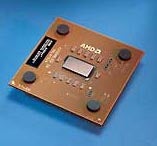 AMD has won its game of "cache up" with Intel. The newest Athlon XP processors, code-named Barton, have double the Level 2 cache of previous models. Our first tests show the results: Barton-based Athlon XP 3000+ systems flew through productivity work, just topping the fastest Pentium 4 systems we've tested. AMD-based PCs also continue to triumph in the pricing contest, often selling for hundreds less than comparably configured P4 computers.
AMD has won its game of "cache up" with Intel. The newest Athlon XP processors, code-named Barton, have double the Level 2 cache of previous models. Our first tests show the results: Barton-based Athlon XP 3000+ systems flew through productivity work, just topping the fastest Pentium 4 systems we've tested. AMD-based PCs also continue to triumph in the pricing contest, often selling for hundreds less than comparably configured P4 computers. 



